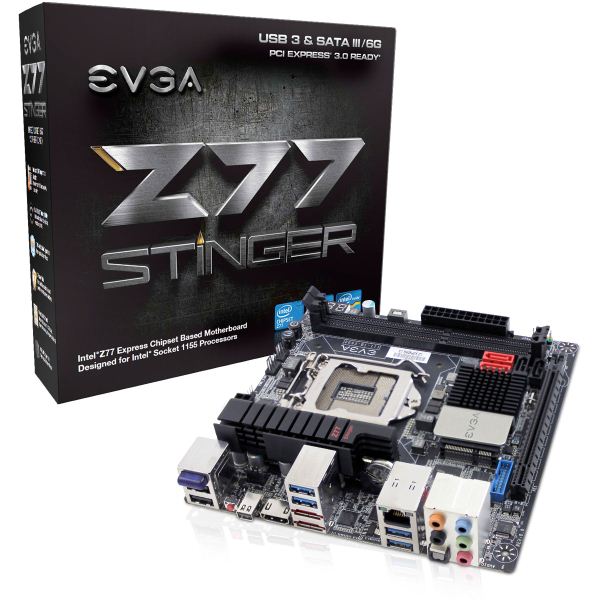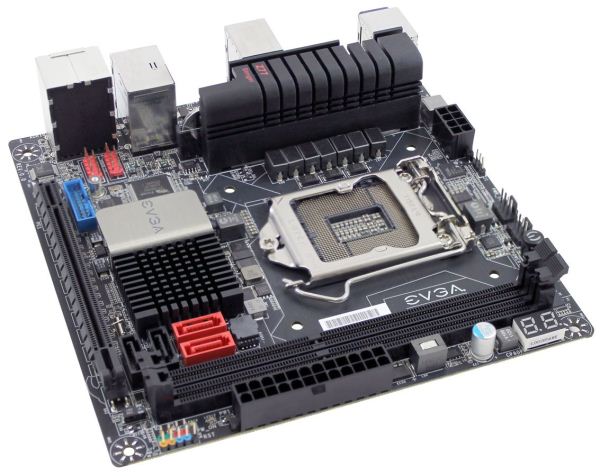Z77 mITX Round-Up: Five of the Best – MSI, Zotac, ASRock, EVGA and ASUS
by Ian Cutress on December 31, 2012 7:00 AM EST- Posted in
- Motherboards
- MSI
- ASRock
- EVGA
- ZOTAC
- Asus
- Ivy Bridge
- Z77
- mITX
EVGA Z77 Stinger Conclusion
EVGA has a reputation for being something a little special. The fan base is loyal, and despite the size of the company they have upgrade paths for their hardware (the EVGA Step-Up program) and deal with all RMA requests personally rather than through the reseller. The forums are always full of posts, and a lot of members also contribute their hardware and spare time for distributed computing projects such as Folding@Home or BOINC. EVGA’s main product line is in NVIDIA graphics cards, and their high end models, although expensive, are often pre-overclocked and sell like hot cakes. They hire top well-known overclockers to showcase how capable their products can be in the right hands.
The motherboard side is less lucrative. EVGA’s market share in the motherboard segment is tiny compared to ASUS and Gigabyte, and still small compared to MSI and Biostar. For a given chipset they rarely release more than three motherboards (e.g. X79 SLI, X79 FTW, X79 Classified or Z77 FTW, Z77 Stinger), and those motherboards are often late to launch and come with some easy-to-spot issues. Every so often they come out with something special (EVGA SR-2) which is hard to ignore.
When I approached EVGA to request a review sample of the Stinger, I had seen the leaked images online and it looked like a good product. I even posted them on AnandTech. When the sample came through the door and I saw the price, I was a little taken aback. $200 puts it as the most expensive mITX board on the market, even more so than the ASUS P8Z77-I Deluxe which uses a daughter PCB for power delivery. At the $200 price point, it was going to be a tough sell to all but EVGA enthusiasts.
For the green we get some ‘extra’ compared to most other mITX boards on the market. This means an Intel NIC, a total of six USB 3.0 ports, two more SATA 6 Gbps (in the form of eSATA), the socket placed at the top rather than the bottom, three fan headers and power/reset buttons with a debug LED. Unfortunately, most of the cheaper boards offer better audio than the Realtek ALC889, they offer a WiFi module included in the product, more video output connectivity, some offer an mSATA, a mini-PCIe, and substantially more IO on the back panel.
BIOS wise EVGA is at a disadvantage due to the size of the company, but the lack of XMP options in the release BIOS does not help much. Despite the two years since graphical BIOSes came into force, I have been told that an implementation may be coming with Haswell (and hopefully with a print screen option). The software side with EVGA also falls against the same hurdle, with only one utility that offers little – no BIOS update feature, no fan control, no network control, no power delivery control.
In terms of performance, all is right with the EVGA Z77 Stinger. We got a fair representation across the range of benchmarks with no out-of-the-ordinary bursts or dips apart from the 192 kHz audio test fail due to the ALC889.
As mentioned before, the EVGA Z77 Stinger is a hard sell, and at $200 it is not really doing itself any favors when compared side-by-side with the competition. There are motherboards out there that offer a lot more in terms of usability and experience, but with EVGA we do get that Step-Up program and direct dealing with RMA. Are these differences worth the $50-$55 jump up from an ASRock or an MSI? If the Z77 Stinger was around the same price as the Zotac, it might be worth a punt.












54 Comments
View All Comments
mike_b - Monday, December 31, 2012 - link
Interesting article, but I have to ask why would someone spend more for a Z77 chipset when using 'just' an i3? Surely a much cheaper H61 chipset could do the job admirably, and at much lower cost.Z77 makes sense if you're overclocking, which is excluded from this test...
IanCutress - Monday, December 31, 2012 - link
H61 has no chipset USB 3.0, no chipset SATA 6 Gbps, and you are limited to PCIe 2.0. H61 is also technically limited to one single sided DIMM per channel, and no SATA RAID. There's also SRT to consider, that would be advantageous with the ASRock and the mSATA on the rear.Ian
mike_b - Monday, December 31, 2012 - link
It might make an interesting comparison to see what net advantage is gained with the added features of the Z77 chipset compared with the H61. If budgets are limited the ~100 dollar cost difference between the Z77 and H61 mainboards makes a big difference; that money saved could be put into something which makes more of a performance difference (SSD rather than HDD for example).Anandtech is one of the best tech sites around, you guys do a great job. I do sometimes see though an emphasis on more expensive products when in terms of real-world performance you could get almost the same thing at a much cheaper price. Might be worth mentioning somewhere.
Not least because with yet another new socket coming with Haswell all these 1155 boards will be seen as out of date soon anyway.
IanCutress - Monday, December 31, 2012 - link
Once we get into the swing with Haswell, we will hopefully covering the whole spectrum. Though it is worth noting that motherboard manufacturers, want to put their best foot forward, and would prefer their halo/channel boards get covered before their OEM / low end offerings. Hence this is why you rarely see many mainstream reviews that are not from forums dedicated to the market segment and users testing their own equipment. We are hoping to rectify the balance in due course. If there are any specific products you might want us to test or examine, drop me an email and I'll see what I can put in my schedule (as full as it is[!]) :)Ian
StormyParis - Monday, December 31, 2012 - link
This is a major issue, not limited to motherboards: whenever I'm looking for something middle of the road or outright cheap, I can't find reviews.These Z77 MBs are a nice example: even though I'm recommending/building PCs regularly, most of them mini-ITX, I never came across a use case for Z77. Nobody apart from teens that still have something to prove overclocks anymore. People who want to do multi-GPU get a big case, and a big board. Are we supposed the extrapolate that the makers of good Z77 boards also make good H77 and H61 boards ?
I understand you've got to make do with what you're given by the OEMs. And that reviews was very good, as usual. Pity it is irrelevant ?
Tech-Curious - Monday, December 31, 2012 - link
That's an interesting observation. I have to say, I never noticed a significant lack of coverage for low-to-mid-range components (either in general or on Anandtech in particular), until this Fall, when I was in the market for a lower end motherboard.I guess I just always gravitated to higher end mobos before. Or maybe the coverage for such products was more comprehensive years ago. My memory's foggy, so it's hard to say.
In any case, motherboards appear to be the exception. If anything, I think the internet has generally grown more bullish on low-to-mid-range CPUs and GPUs in recent years (probably, in part, as a result of the stagnating console situation, which results in stagnating system requirements for games).
But all of that rambling aside, yeah. It'd be nice to see more diverse motherboard analysis. When I bought a b75 a couple of months ago, I literally couldn't find a review for that chipset. It wasn't a big deal; it's not like b75's features are any great mystery, after all -- but it is a little nettlesome to trip over sixty bajillion z77 reviews when there's nary peep about any other chipset.
In other news, Ian's review is a good one -- and given that I've been a faithful user of Asus motherboards for the last 15 years, it's nice to see them take home the prize. :)
Etern205 - Saturday, January 5, 2013 - link
My guess would be, why review a cheap board when majority of the readers here won't even bother buying it?And as for Asus boards, I've heard, they do something called based-line features. This means all boards from the bottom of the range to the top (Intel B75-Z77) will have the same base-line features, other features are just added like BT, WiFi, extra lan, etc.
Tech-Curious - Wednesday, January 9, 2013 - link
Yes, I think the issue is that (at least with respect to Intel chipsets) low-end motherboards don't support overclocking. So they're both less interesting to review (fewer measurable differences in performance among different models), and they're less appealing to the presumed audience of sites like Anandtech.Still, the B75 is a perfectly good chipset. If you aren't heavily invested in overclocking, z77's advantages are likely wasted on you. Personally, I'm well beyond my overclocking days; I just don't have the time or the patience to go through the almost endless tuning process anymore. (Even if you find a stable OC at the outset, it can become unstable later, and/or a given application might expose instability that stress testing didn't, weeks or even months down the road).
jonjonjonj - Friday, January 4, 2013 - link
just cause you don't overclock doesn't mean other people don't. why wouldn't you? because you want to get the fastest cpu that you can afford means you have something to prove? some people are just idiots.Zap - Monday, December 31, 2012 - link
But there isn't a $100 difference between H61 and Z77. There is a cheaper Gigabyte Z77 ITX board that's only around $60 more than the cheapest H61 ITX board, and it was even on sale recently for another $13 off making it less than $50 difference.Alternately one can go the H77 ITX route and get all the Z77 goodies except for overclocking, for around $30 less than the cheapest Z77 ITX. I think $30 more than H61 is reasonable for those extra features, plus guaranteed out-of-the-box BIOS support for Ivy Bridge.
I do agree with your (mike_b) first post regarding the choice of CPU used. Ian Cutress, didn't you have a spare K CPU laying around? There are so many people building overclocked ITX rigs these days. I did in a Silverstone SG05 with low profile air cooler to hit 4.2GHz. Plenty of others use the Bitfenix Prodigy and liquid cooling to hit clocks normally reserved for ATX rigs. Another review site (Tweaktown) tested overclocking on Z77 ITX boards and the ASRock hit near 4.8GHz. THAT'S what I want to see.
Of course this AnandTech roundup has some very useful information too, such as DPC latency tests and POST times. Keep up the good work there! But please, know your audience. Next time if the board is supposed to be overclockable, test that feature.
Maybe there can be a companion article about overclocking and heatsink clearance? Would be a shame to not overclock this nice collection of Z77 ITX boards.